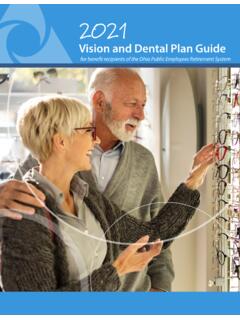Transcription of TABLE OF CONTENTS - Energy
1 TABLE OF CONTENTS1 INTRODUCTION FEMP-DESIGNATED PRODUCTS Energy EFFICIENCY METRICS3 DESIGN PROCESS STEP-BY-STEP OVERVIEW6 COMPONENTS OF THE DESIGN DESIGN CONSIDERATIONS LIGHTING DESIGN CONSIDERATIONS LUMINAIRE DISTRIBUTION COLOR QUALITIES LIGHT SPECTRUM13 PARKING LOT LIGHTING DESIGN DESIGN SCENARIO OVERVIEW DESIGN SCENARIO GENERAL LUMINAIRE DESIGN SCENARIO FEMP-DESIGNATED LUMINAIRE17 LIGHTING CONTROLS SAVE Energy STATIC CONTROLS MULTI-LEVEL CONTROLS20 COST-EFFECTIVENESS21 RESOURCESINTRODUCTIONL egislation and the Federal Acquisition Regulations (FAR) require federal agencies to specify and buy Energy STAR qualified products or, in categories not included in the Energy STAR program, products that meet or exceed efficiency requirements designated by the Federal Energy Management Program (FEMP). Agencies that follow requirements to buy efficient products can realize substantial operating cost savings and reduce pollution.
2 As the world s largest consumer, the federal government can help lead the entire market to achieve greater Energy efficiency while saving taxpayer provides acquisition guidance and federal efficiency requirements across a variety of product categories, including outdoor pole-arm-mounted area and roadway luminaires, which are a FEMP-designated product category. Federal laws and executive orders mandate that agencies meet these efficiency requirements in all procurement and acquisition actions that are not specifically exempted by purpose of this guide is to explain in greater detail the FEMP-designated outdoor pole/arm-mounted area and roadway product category, to show how the equipment can be used to maximize total Energy efficiency (using the metrics defined below), and to provide an estimate of the cost effectiveness of using FEMP-designated EFFICIENCY METRICST here are different Energy efficiency metrics.
3 Although there are several metrics to describe Energy effi-ciency, here we consider three lighting-specific metrics: efficiency (very simple), efficacy (simple), and lighting power density (complex). This guide primarily focuses on efficacy, and demonstrates how efficacy incorporated with other elements can reduce power densities. EfficiencyEfficiency is a measure of how effectively a device converts input into output. Luminaire efficiency (LE) is the light leaving the luminaire divided by the light generated by the bare lamp (light bulb) when operated outside of the luminaire. Because both values (the light leaving the luminaire and the light generated by the light source[s]) have the same unit, luminaire efficiency is therefore a unitless is the capacity to produce an effect. In lighting, efficacy is measured in lumens per watt (lm/W, also abbreviated LPW).
4 Efficacy can apply to light sources or luminaires. The greater the efficacy, the more light is generated for the same watts. Most people are familiar with this metric related to vehicles; for example, a car that gets 30 miles per gallon is more efficacious than a car that gets 25 miles per s designated product for lighting focuses on luminaire efficacy and uses the term luminaire efficacy rating (LER). The following page explains how to calculate the LER as well as the relationship between lumi-naire efficiency and luminaire efficacy. A key note regarding efficacy is that it counts the emitted lumens irrespective of the direction in which they are emitted, or the usefulness of those lumens. A luminaire can have a lower LER but do a better job of dis-tributing light to an identified Power DensityLighting power density (LPD) is the total input power ( , including the driver or ballast) multiplied by the total number of luminaires divided by the area in which the equipment is installed.
5 Many Energy codes use this metric; however, it does not actually focus on Energy . Energy is power multiplied by time, so it is important to distinguish between power (watts) and Energy (watt-hours). Lighting power density calculations do not indicate any Energy savings as a result of the use of lighting LOT LIGHTING GUIDE 12 PARKING LOT LIGHTING GUIDEFEMP-DESIGNATED PRODUCTSAs of September 2013, there are FEMP-designated products for lamps (light bulbs), ballasts, interior fluores-cent luminaires, industrial high-bay luminaires, and many exterior luminaires. The metric for luminaires is the LER. The following provides the LER value for parking lot luminaires (classified within FEMP as outdoor pole/arm-mounted area and roadway luminaires) as well as helpful REQUIREMENTS FOR PARKING LOT LUMINAIRESO utdoor pole/arm-mounted area and roadway luminaires must have an LER of 65 to be FEMP-designated (as of the date of this publication; the most current value as well as FEMP-designated products can be found at Covered Product Category: Exterior Lighting).
6 The following explains how to calculate LER for conventional light sources such as fluorescent, metal halide, and induction lighting, as well as light-emitting diode (LED) =total light leaving the luminaireinput powerConventional LuminairesConventional luminaires (non-LED) can use different combinations of lamps, ballasts, and optics; often requiring LER to be calculated. If an LER is not available, buyers may estimate the LER using this formula:LER =luminaire efficiency x lamp lumenslamp+ballast input wattsLE x lamp lumens, and lamp+ballast (system) input watts are typically found in manufacturers product catalogs and photometric LER formula may be used with generally available component performance data to determine the mini-mum performance of other components. For example, known values may be used to calculate the lowest LE necessary to meet an LER requirement:A 200-watt high-pressure sodium (HPS) lamp produces 22,000 initial lumens with 230 lamp+ballast input watts.
7 What LE is necessary to meet the minimum required LER of 65?LE = LER lamp+ballast input wattslamp lumens=65 lm/W 230 W22,000 lumens= , for a minimum required LER of 65, a fixture combined with the lamp and ballast values provided must have an LE of at least 68%.LED LuminairesLED luminaires are available in different combinations, but their values are reported for the complete lumi-naire, not the light source by itself. The complete LED housing includes the fixture, light source (or lamp), and driver (similar to a fluorescent ballast). If an LER is not available, buyers may calculate the LER for LED luminaires using this formula:LER =luminaire light output (lumens)input power (watts)DESIGN PROCESSThe rest of this document will explain options for Energy efficient lighting in parking lots using FEMP-designated luminaires and features accounting for both lighting quality and Energy efficiency.
8 Selecting Energy efficient equipment, such as FEMP-designated equipment, is the first step in Energy efficient parking lot lighting. This section address a step-by-step process from surveying the site to installation. Key points of the following design process section include:1. Developing an inventory of equipment2. Determining lighting quality and quantity needs3. Incorporating lighting controls4. Addressing cost effectiveness in the process4 PARKING LOT LIGHTING GUIDESTEP 1: CONDUCT COMPLETE INVENTORYC onsider all lighting opportunities and list the luminaires that you want to replace, and ask why you want to replace them. Is Energy the only issue? If this is a retrofit, be sure to collect information on each luminaire that you want to replace ( , lamp type(s), mounting height of luminaires, general lighting information). Please note, entrances to the parking lot and areas near the building may use different luminaire types than basic parking 2: CONSIDER LIGHT QUANTITY AND QUALITYThe lighting for a parking lot is dependent upon the type of building or site that it supports as well as the surrounding area of the site.
9 A parking lot at a national park should not have the same lighting requirements as a secure federal facility. The Illuminating Engineering Society of North America (IES) recommends light levels for basic parking lots and higher light levels for parking facilities where enhanced security is required. More light does not equal better quality. Most security cameras are rated for both very low and very high light levels, but are limited by contrast ranges. Therefore, uniform lighting will aid in viewing images on the camera as well as those physically in the parking uniformity on the pavement surface must also be considered for safe vehicle and pedestrian interaction. Too much contrast between bright and darker areas makes it more difficult to see people and vehicles in the darker areas. The use of luminaires that distribute light evenly on the parking surface and lighting layouts with appropriate spacing, are crucial to the lighting design.
10 Consequently, one-for-one replacement may not be an option when specific light levels and uni-formity ratios are targeted. Factors such as trees and other elements on the site may affect the lighting design. You can refer to IES resources or your local light-ing professional for assistance. Contact the International Association of Lighting Designers and/or the IES to locate lighting 3: CONSIDER CONTROLS FOR ADDITIONAL SAVINGSMost parking lots are lighted for 13+ hours per day; lighting controls can be used to save Energy at times of infrequent use. Parking lots are often empty during cer-tain periods at night; using controls to reduce the lighting during these periods will help save Energy . Consider circuiting the luminaires on the site so certain lumi-naires can be either reduced in output or turned off during periods of inactivity. For example, luminaires along the perimeter could be reduced to direct users to park closer to the building during evening operation hours.













